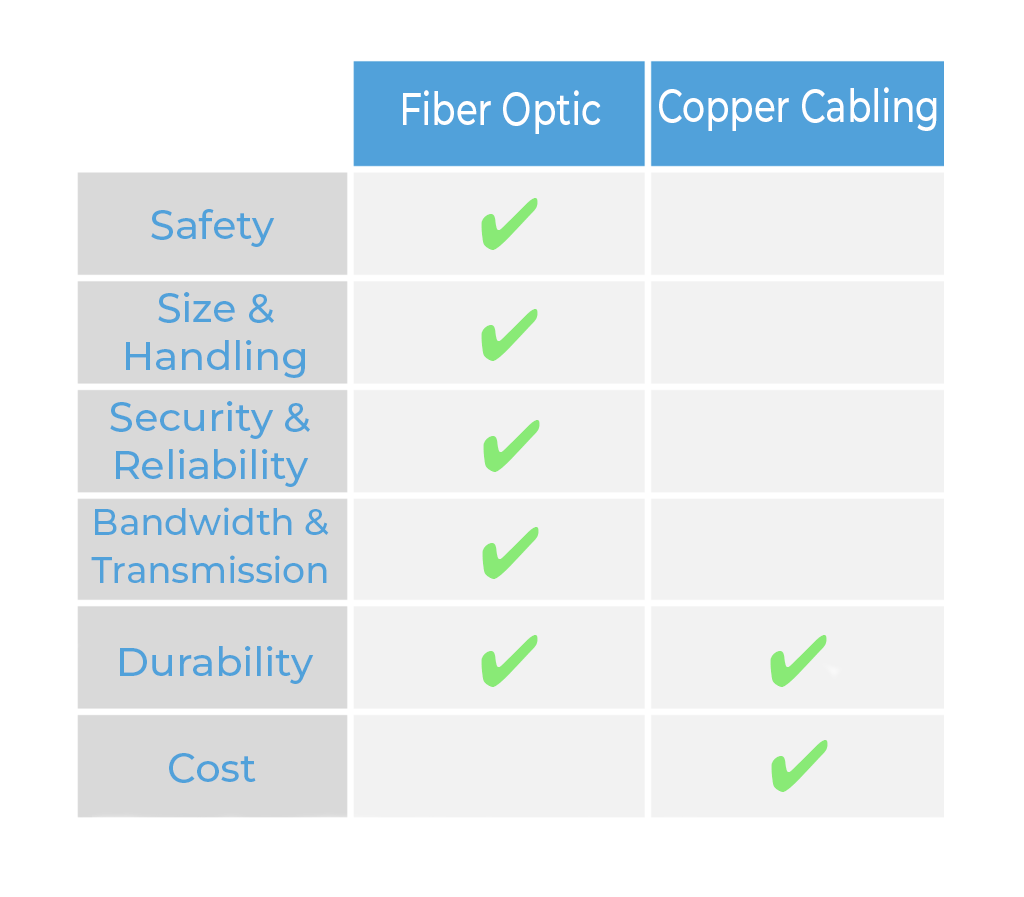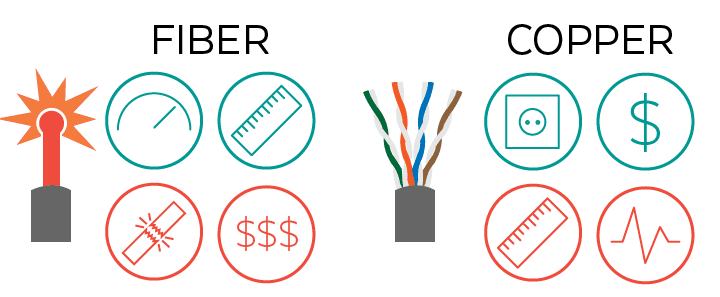What’s the Right Choice For You?
As the Internet has become an essential part of our lives, the debate continues between which cabling system is best for your networking solutions. While both cable types transmit data, both types of cabling systems come with their own set of benefits and shortcomings. In order to understand these differences, one must first understand how they work. Copper cables carry electrical pulses along metal strands and have many types such as Cat5, Cat6, Cat7 and Cat8, which can reach different transmission speeds. While copper is getting faster with Cat8 Ethernet reaching up to 40Gbps for 20 meters, it still has notable limitations with regard to distance. On the other hand, Fiber optic cables are made from fine hair-like glass fibers that carry pulses of light along flexible glass threads. Fiber does not conduct electricity and is therefore impervious to radio frequency interferences and allows for faster speeds at longer distances. The difference in transmission speeds, durability and reliability often equates to optical fiber being the optimal solution for new and upgraded networks. However, to help you to decide what is best for your networking systems, here are 6 factors that will differentiate fiber optic and copper cabling solutions:
Safety:
When looking at the category of safety, we have to analyze the likelihood of circuit breaks and the conductive capabilities of both types of cables. Since optical fiber does not transmit electricity, it does not radiate signals and tends to be safer in electromagnetic environments. This means that they can be safely used around electrical transmission lines as well as in high radio frequency and magnetic fields. In addition, a broken or damaged optical fiber can be detected extremely quickly by using a number of monitoring techniques including monitoring the power transmission or the transmission of a pilot signal. With a suitable crowbar circuit, the laser transmission in fiber optics can be shut off within 1-2 microseconds.
In contrast, copper cables use electricity and are susceptible to breaks that cannot be detected and mitigated as efficiently. Without efficient monitoring techniques, copper cables are also more prone to shorting out or causing a fire if wires are damaged, old or worn. Unless great care is taken in the circuit design to detect breaks and minimize energy storage, the arc can be extremely hazardous and can be fatal if even a small fraction of the power escapes.
Size & Handling:
Fiber optic strands are extremely narrow in comparison to standard copper cable which is roughly four times the width of fiber optic cables. While fiber optic strands are about the same diameter as a human hair, they can transmit incredible amounts of data, at much higher speeds, over much longer distances than their much heavier, much thicker copper counterpart. In addition to being much lighter and much thinner, the size reduction in cabling mass comes with some major benefits. Fiber optic cables take up much less space, is more flexible which makes it easier to access and manage. In general, this freed up space means better circulation in data centers and tends to look more aesthetically pleasing.
Security & Reliability:
A radio frequency (RF) signal refers to a wireless electromagnetic signal used as a form of communication. Copper network connections naturally generate a field of interference around the cables. When you have multiple cables running near one another, this interference can bleed into nearby cables, hindering desired messaging and posing potential security risks. While copper wires can leak signals and can be impacted by radio frequency interference (RFI), in extreme cases, copper wire can pick up energy from nearby high power transmitters, not only interfering with data transmission but potentially overheating the wire. On the other hand, optical fibers are not a conductor and therefore have no radio frequency and electromagnetic interference (EMI) issues. The light transmission in fiber optics does not generate any EMI or RFI, so fiber winds up being more secure and requires less re-transmission resulting in a greater return on investment.
Bandwidth & Transmission:
Bandwidth is a measurement of the amount of data that a server or network transmits/receives over a given amount of time. Having enough bandwidth is critical to modern business operations. If your data connection lacks bandwidth, you may struggle to use cloud applications or communicate with clients through voice-over-IP phones, web conferencing, or other forms of communications.
Although copper is perfectly adequate for a voice signal, it has very limited bandwidth – while fiber provides standardized performance of at least 10 Gbps (Giga bits per second) and beyond. If you’ve reached the bandwidth limits of your existing Internet service, scaling your data connectivity to increase bandwidth is necessary to protect productivity and growth.
Fiber links provide over 1,000 times as much bandwidth as copper and can travel more than 100 times further as well. While a typical bandwidth-distance product for multi-mode fiber is 500 MHz/km, twisted pair copper cables optimized for high data rates (Cat 6) can transmit 500 MHz over only 100 meters. In addition, the signal loss over 500 meters in fiber is inconsequential while copper has very high loss at high frequencies. One source estimates that fiber loses only 3% signal strength going over 100 meters in distance. By contrast, copper loses 94 % over the same distance. Overall, because light can travel for much longer distances over a fiber cable without losing its strength at higher bandwidth capabilities, fiber optic cabling is the clear winner for both bandwidth and efficient data transmission.
Durability:
Both fiber and copper are reasonable in terms of durability. Overall, the ultra-pure silica glass used in optical fiber has a higher tensile strength than copper. The jacketing material used in optical fiber works to further strengthen and protect the fiber. Although fiber is made of glass, copper wires are more prone to damager over time. When considering durability, we also have to make note of the long-term use of cabling networks. Every year, the amount of data we consume increases as do bandwidth requirements and speed preferences. When talking to our customers about the long-term investments of their cables, we have to take into consideration which infrastructure will be around for the long haul. In most cases, investing in a modern fiber optic cabling system will allow networks to operate at future speeds without the need to replace cabling infrastructure. A solid multi-fiber backbone in a structured environment will likely last for years, if not decades, and will continue to support increasing bandwidth needs. On the other hand, the average lifespan of a copper wire network is a little over five years. This means that you will not have to worry about replacing optical fibers as frequently as copper wires. It’s something to think of when making a decision that will allow you to have the most return on investment.
Cost:
Generally, a fiber optic network is going to cost more than copper cable transmissions. The reason for the higher cost lends itself to the fiber optic’s laser system which is not present in the electrical system. Although this price gap is shrinking with new developments in internet technology solutions, it is always best to check all options before deciding which cabling solution would work best for you in the long run.

The Bottom Line
The right cabling solution for your network really depends on your individual needs. If you have significant bandwidth requirements, we believe that investing in a robust scalable infrastructure will pay off in the long run. With faster speeds, increased durability, cleaner signaling and space-saving characteristics, fiber optic cabling systems have provided a great ROI for our customers. Copper cables also have their applications and can help reduce upfront costs. If your business has multiple locations, a fiber optic connection at the home or hub office – with copper cable connections at other locations – can often be an effective solution for balancing speed and capacity with affordability. A combination approach can definitely provide a balanced solution with an eye toward future growth. Give us a call if you need help fine-tuning your options and we can come up with a plan that is best suited for your business.
The ITS Hawaii Team

